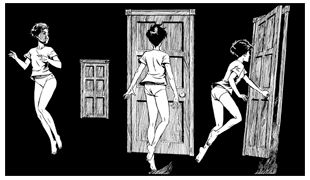Apis Teicher reviews Craig A Taillefer’s Wahoo Morris, a webcomic about a struggling music group that deftly avoids the cliches of such a story and also injects an intriguing dose of magical realism into the mix.
There’s something to be said for the combination of music and magic, as they each have a way of making the other more powerful. When looking at webcomics that deal with the idea of music groups, bands, groupies and the struggles that ensue its not rare to fall into the many clichés and into a series of well exploited stereotypes – so much so that as the reader one might come across a new strip and automatically prejudge it.
Craig A Taillefer’s Wahoo Morris is in a class on its own, seamlessly blending some of the most well crafted comic art on or off the net and believable, intriguing characters. Straddling a thin line between flat out fantasy and the more elusive magical realism, it follows a band of aspiring musicians as they struggle to break out, deal with the complex relationships within the group… and quite possibly a dark demonic influence insinuating itself into their lives.
Taillefer is an incredibly prolific artist, and he seems to always be trying out new projects. Under his belt are already some impressive credentials, both amateur and professional – the man is a consummate inker, something that he incorporates into the persona of the protagonist. While updating Wahoo Morris weekly, he still finds the time to devote his attention to other projects hosted on Hip Gotta Go Graphics. Wahoo Morris has to date ninety two pages and yet one goes through the storylines so gracefully that it hardly seems that long. What has been published of it so far is only a teaser, as only now all the elements seem to be falling into place for some of the darker aspects of the story.
What makes the comic so addictive? It’s a rare perfect balance of intriguing plot, realistic and charismatic characters, believable dialogue and the luscious art. The characters are distinctive and very human, including having their bouts of insecurity and temper. The camaraderie between the characters feels genuine. He also incorporates little personality quirks that strike a nerve with the readership, even using something as subtle as a choice in foods, as complex as setting it in a very realistic culture – such as having references to British Columbia’s Haida art.
The humor in Wahoo Morris is understated and realistic, and the kind of thing most of us have likely fantasized about at some point and what really completes the mood is Taillefer’s impeccable sense of timing and mood.
 As for the art itself, this is largely what holds the reader’s interest from the get go. A refreshing departure from the CG coloured manga style so prevalent in many webcomics, Wahoo Morris seems more out of the pages of the traditional Tarzan comics – a nod to something that helped inspire him, by Taillefer’s own admission. While the character designs are deceptively simplistic, his gift as an inker really shines through. His detailed and incredibly complex backgrounds and architecture provide a visual feast. His black and white work is simply stunning, and his technique flawless. His talent with inanimate objects is only overtaken by his ability to draw animals — from Dalmatians, to birds of prey and rodents. The range of expressions and emotions that he manages to convey through them is simply amazing. Add to it an uncanny ability to letter and use sound effects for their maximum effect and you can see how the whole package comes together. Overall, this is one ambitious effort that could’ve easily fell flat, guilty of overreaching – but Taillefer manages to weave it all together with the grace of a master storyteller, leaving the reader utterly hooked.
As for the art itself, this is largely what holds the reader’s interest from the get go. A refreshing departure from the CG coloured manga style so prevalent in many webcomics, Wahoo Morris seems more out of the pages of the traditional Tarzan comics – a nod to something that helped inspire him, by Taillefer’s own admission. While the character designs are deceptively simplistic, his gift as an inker really shines through. His detailed and incredibly complex backgrounds and architecture provide a visual feast. His black and white work is simply stunning, and his technique flawless. His talent with inanimate objects is only overtaken by his ability to draw animals — from Dalmatians, to birds of prey and rodents. The range of expressions and emotions that he manages to convey through them is simply amazing. Add to it an uncanny ability to letter and use sound effects for their maximum effect and you can see how the whole package comes together. Overall, this is one ambitious effort that could’ve easily fell flat, guilty of overreaching – but Taillefer manages to weave it all together with the grace of a master storyteller, leaving the reader utterly hooked.
Comments are closed.